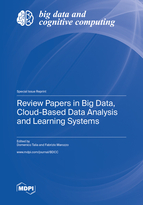Review Papers in Big Data, Cloud-Based Data Analysis and Learning Systems
A special issue of Big Data and Cognitive Computing (ISSN 2504-2289).
Deadline for manuscript submissions: closed (28 February 2023) | Viewed by 83845
Special Issue Editors
Interests: big data analysis; parallel machine learning; scalable data mining; distributed computing systems; parallel programming and data science
Interests: big data analysis; social media analysis; cloud computing; data mining; machine learning; Internet of Things
Special Issues, Collections and Topics in MDPI journals
Special Issue Information
Dear Colleagues,
Big data analysis is enabling researchers and data scientists to extract useful information and knowledge to make new discoveries and support decision-making processes. To this end, the use of advanced and scalable algorithms, along with parallel programming frameworks and high-performance computers, is commonly used to solve big data problems and obtain valuable information and learning processes in a reasonable time.
This Special Issue will include high-quality papers, i.e., review/survey papers and original research articles, in the fields of big data, cloud-based data analysis, and learning systems. The papers will be published in an open access format by the Editorial Board Members or those invited by the Editorial Board Members and the Editorial Office. Papers will be published, free of charge, after peer review. In particular, wide-ranging surveys and advanced research are sought after, both on aspects relating to big data (e.g., frameworks for big data analysis or systems for big data management) or the use of big data in specific areas (e.g., big data from social media or big data from streams).
The scope of this Special Issue of Big Data and Cognitive Computing includes, but is not limited to, the following topics:
- Big data (along with clouds, Internet of Things and social media platforms);
- Big data infrastructure and systems;
- Big data processing and analytics;
- Big data models, algorithms, and architectures;
- Cloud computing and big data platforms;
- Cloud services and big data applications;
- Data storage and management;
- Data search and mining;
- Big data applications in science, Internet, finance, telecommunications, business, medicine, healthcare, government, transportation, industry, manufacturing, etc.;
- Social media analysis;
- Big data integrity and privacy;
- Edge computing and IoT data mining;
- IoT technologies for big data collection;
- IoT sensing and cognitive IoT;
- Data-driven IoT intelligent applications;
- 5G networks and wireless big data.
- Cognitive computing;
- Machine learning and its applications in medicine, biology, industry, manufacturing, security, education, etc.;
- Deep learning;
- Artificial intelligence;
- Affect/emotion/personality/mind computing;
- Cognitive modeling;
- Cognitive informatics;
- Cognitive sensor-networks;
- Cognitive robots;
- Application of cognitive computing in health monitoring, intelligent control systems, bioinformatics, smart manufacturing, smart grids, image/video and signal processing, etc.;
- Robots and control systems;
- Natural language processing;
- Human–machine/robot interaction.
Prof. Dr. Domenico Talia
Dr. Fabrizio Marozzo
Guest Editors
Manuscript Submission Information
Manuscripts should be submitted online at www.mdpi.com by registering and logging in to this website. Once you are registered, click here to go to the submission form. Manuscripts can be submitted until the deadline. All submissions that pass pre-check are peer-reviewed. Accepted papers will be published continuously in the journal (as soon as accepted) and will be listed together on the special issue website. Research articles, review articles as well as short communications are invited. For planned papers, a title and short abstract (about 100 words) can be sent to the Editorial Office for announcement on this website.
Submitted manuscripts should not have been published previously, nor be under consideration for publication elsewhere (except conference proceedings papers). All manuscripts are thoroughly refereed through a single-blind peer-review process. A guide for authors and other relevant information for submission of manuscripts is available on the Instructions for Authors page. Big Data and Cognitive Computing is an international peer-reviewed open access monthly journal published by MDPI.
Please visit the Instructions for Authors page before submitting a manuscript. The Article Processing Charge (APC) for publication in this open access journal is 1800 CHF (Swiss Francs). Submitted papers should be well formatted and use good English. Authors may use MDPI's English editing service prior to publication or during author revisions.







